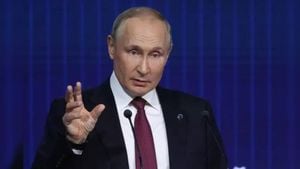U.S.-Ukraine relations took another significant turn recently as Ukraine reportedly fired British-made Storm Shadow missiles deep within Russian territory for the first time. This operation marks both a strategic escalation and showcases the growing military capabilities of Ukraine amid its intense conflict with Russia. A source disclosed this development to Sky News, highlighting the serious nature of the Ukrainian counteroffensive and the tactical decisions being made on the ground.
General Sir Richard Barrons, who previously commanded the UK's joint forces, commented on the overarching situation by stating the counteroffensive is unlikely to end the war. According to him, Ukrainian forces, numbering possibly between 30,000 to 60,000, are significantly outgunned and outnumbered by approximately 300,000 Russian troops across the nearly 900-mile frontline. He predicted the war might drag on for up to three years, remarking, “as long as the Ukrainian will to fight exists, as long as the Western will to keep paying and equipping them exists,” the conflict is bound to persist.
The circumstances surrounding this escalation involve complex geopolitics, with the U.S. recently approving the provision of anti-personnel mines to Ukraine. This decision, made by President Joe Biden, aims at bolstering Ukraine's defensive capabilities, especially as Russian forces mount their own offensives. The provision of landmines is particularly controversial, as rights groups have condemned this move, arguing it undermines global arms control initiatives.
Despite intense fighting and aggressive artillery exchanges, Ukraine’s early gains from its incursion have faced significant setbacks. Recent reports indicated Russian forces have gained substantial territory—almost six times more than they did last year—affecting both the dynamics on the eastern front and logistical hubs across key regions like the Donbas. The Institute for the Study of War (ISW) reported Moscow's troops have seized approximately 2,700 square kilometers of Ukrainian land since the start of 2024, demonstrating the increasing pace and intensity of Russian advances.
Ukraine’s efforts to reclaim lost territory have been met with growing challenges. The incursion attempts, such as the significant offensive toward the Kursk region, initially provided hope and morale boosts. Nevertheless, experts classify these efforts now as more of a strategic misstep than outright success. Dr. Marina Miron, a defense researcher, noted, “the whole idea was to maybe gain some political leverage,” but instead, Ukrainian units are reportedly becoming bogged down, diverting resources from other fronts. This situation has raised concerns about the sustainability of Ukraine’s military efforts under such conditions.
The dire situation is compounded by concerns about leadership changes and policy shifts with the upcoming administration of Donald Trump, who has voiced intentions of negotiating peace swiftly upon taking office. Critics worry this might lead to decreased military support for Ukraine and altered alignments with American global policy.
Meanwhile, the front lines continue to shift dangerously. The Ukrainian forces are reportedly starting to withdraw from certain eastern sectors to conserve strength. The dynamics of the conflict reveal what some analysts describe as Moscow's tactical advantage. The ISW pointed out how Russia maintains control over significant logistics routes, including the pivotal area of Kupiansk, which was previously liberated during earlier Ukrainian offensives.
Simultaneously, footage circulating on social media indicates fierce battles occurring within the Russian Kursk region. Here, both sides suffer heavy losses, yet the extent of destruction and fighting suggests the pressure Ukrainian forces face is intensifying, impacting their overall effectiveness. Matched with the difficulties of maintaining current fronts against resilient Russian reinforcements, analysts express concrete concerns about the disintegration of Ukrainian defenses under relentless enemy pressure.
Alongside military maneuvers, the human toll remains staggering. Recent estimates by BBC Russian indicated more than 78,000 Russian military personnel have been lost since the onset of the full-scale invasion. Although heavy casualties are afflicting both sides, reports show Russian commanders may be employing particularly aggressive strategies with high human costs, leading to civil rights concerns and fears over potential war crimes.
The interplay between military tactics, leadership decisions, and international dynamics continues to shape the course of the war. Ukraine's recent missile strikes signify both resilience and desperation as the nation seeks to defend and reclaim its sovereignty against increasingly fortified and determined Russian forces. With distant but looming negotiations on the horizon, the battlefield remains the ultimate arbiter of power and influence, forging the paths the involved nations take moving forward.
This complex theater of conflict emphasizes the intertwining of military strategy with political chess, and as both sides weigh their options, the future of Ukraine remains intricately bound to its capacity to resist, adapt, and negotiate amid shifting allegiances and battlefield realities.



